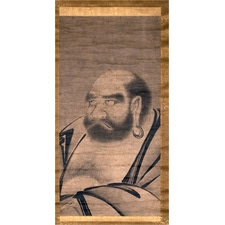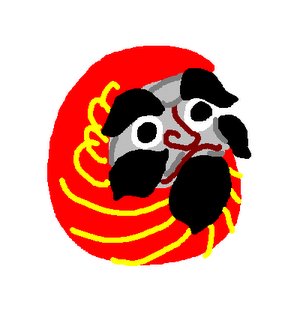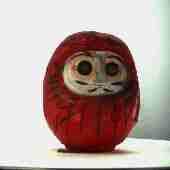. Kokeshi, こけし / 小芥子 / 子消し wooden doll .
:::::::::::::::::::::::::::::::::::::::::::::::::::::::::::::::::::::::::::::::::::::::::::::::::::::::
Kokeshi, Wooden Dolls こけし,
new ambassadors
for Tohoku Japan -
Kokeshi Dolls
. Japan after the BIG earthquake March 11, 2011
.......................................................................

Kokeshi dolls are quite famous and so we find many homepages concerning this item. This is an ongoing story and here is part 1 of it, concerned with a Daruma painted on a wooden doll with girl’s features. Wooden dolls of a similar type with only a Daruma face are called “Kiji Daruma” and will be introduced in their own story.
There are so many HP about kokeshi, more than 5000 in English and 35000 in Japanese, so this is just a small selection.
In part 1 (this one) you find general information about kokeshi and how to make them. Then the types of Miyagi prefecture are introduced.
Part 2 deals with Tsugaru kokeshi, which feature many Daruma kokeshi too.
Part 3 looks at Yamagata, Fukushima and some other famous kokeshi areas.
こけしの話がながい!HPもたくさんあります。
日本語では35000以上、英文だけでも5000以上です!
パーツ1では、一般情報、作り方や宮城県のこけし。
パーツ2では、津軽こけし、青森県のだるまこけしなど。
パーツ3では、山形県、福島県などのこけしを紹介します。
. Kokeshi こけし / 小芥子 / 子消し wooden dolls .
kibokko 木ぼっこ / 木ぼこ kiboko
- - - and folktales - Introduction -
. Kokeshi with Daruma san だるまこけし / ダルマこけし .
:::::::::::::::::::::::::::::::::::::::::::::::::::::::::::::::::::::::::::::::::::::::::::::::::::::::::::::::::::::::::::

Kokeshi, From Tohoku with Love Paperback
by Manami Okazaki
Kokeshi from Tohoku with Love
is a book that looks at the craft and culture of kokeshi dolls. Kokeshi are the traditional dolls that are made of wood and are characterized by their lack of arms or legs. They are produced in the Tohoku region of Japan and were originally a children's toy, although it is more often used as a form of decoration nowadays and displayed in the home. Abroad, they are considered to be an icon of Japan, and reflect Japanese aesthetic sensibilities with their simple, elegant and minimalist designs.
Kokeshi have the appeal of imperfection and hand made exclusivity as no two dolls are the same, each kokeshi embodies the qualities of wood, something that is often referred to as "warmth.” In fact, for collectors, more than the freshly made kokeshi, many covet the atmosphere of the vintage kokeshi-- rather than degrading, as with plastic or artificial materials, the wood picks up a dewy, subdued colour and the delicately painted features fade gracefully with time. This book is the only English language book that looks at this culture in depth and is the only book with English language interviews with the masters of the craft.
The author, Manami Okazaki, visits all 6 prefectures of Tohoku to profile 20 artisans in the remote hot spring villages where they are made. Included are the work and interviews with the masters to the up and coming artists, and highlights many aesthetic theories and sensibilities that are prevalent in contemporary design, even today. The book also looks at Japanese hotspring culture, and Tohoku culture to paint a holistic picture of kokeshi culture. This book will delight fans of wooden crafts, Japanese culture and travellers to Japan. The book gives an insight into the psychology of the craftsman, the process of production, the motifs and the various types, which will inform the collector. This book will also suit travelers to Japan who wish to explore the Northern region of Japan, and their charming hot spring villages. Included are hundreds of photographs.
This book is intended for charity and all proceeds will go to schooling in Tohoku post March 11 tsunami.
- source : www.amazon.com
:::::::::::::::::::::::::::::::::::::::::::::::::::::::::::::::::::::::::::::::::::::::::::::::::::::::::::::::::::::::::::

こけし - 日本の郷玩事情
- source : mingei jetlink
:::::::::::::::::::::::::::::::::::::::::::::::::::::::::::::::::::::::::::::::::::::::::::::::::::::::::::::::::::::::::::
. Kendama Kokeshi Daruma こけしけん玉・福だるま
Kokeshi Adventures こけしの冒険
a blog by John
source : kokeshi-adventures.blogspot.com
Kokeshi Wiki - 現代に生きる「こけし辞典」への挑戦です。
source : kokeshiwiki.com

source : www.wakomono.jp
(卯三郎こけし)- Hina Doll Kokeshi
:::::::::::::::::::::::::::::::::::::::::::::::::::::::::::::::::::::::::::::::::::::::::::::::::::::
Almost everyone familiar with Japanese dolls knows about kokeshi. The cylindrical wooden dolls without limbs are created on lathes and are brightly painted with floral designs and a girl's face. Most people look at kokeshi and wonder how what is basically a cylinder of wood with a ball stuck on could be a play doll. Kokeshi dolls originated in the northern region (Tohoku, Toohoku東北) of Honshu (the main island).
Many people believe that early kokeshi were representations of girl children that were aborted or put to death after childbirth due to the inability to support a poor family of greater size.
Even the word, ko-keshi (ko o kesu 子を消す), can be loosely translated as "extinguished child" or “a child wiped out”.
- - - - - see also
The medochi use human females to have them bear their children. When the child is born, the Medochi comes to claim his child. If the woman throws the baby into the water to kill it, Medochi takes the bones with him.
. Medochi メドチ, めどち Kappa, water goblin .
It may be that kokeshi were kept as reminders of a dead child's plaything. Kokeshi are also given as charms to childless women in an effort to get pregnant. Kokeshi were kept in the family and passed down from generation to generation. Some believe that kokeshi date back three hundred years and were the north's equivalent of the standing hina dolls.
Some kokeshi dolls have their heads made from the same piece of wood as the body, however most heads are separate. They are attached by heat friction with the body rotating on the lathe while the head is fitted on the spindle that holds the head. The wood surrounding the hole at the base on the head eventually cools and contracts to a snug fit. Supposedly the sign of a good kokeshi is a head that squeaks when rotated, but some are just made to do that. Their nickname is “Kina-Kina-Ningyoo”, roughly translates as “Squeeking, Squeeking Doll”.
The sizes of old kokeshi range from 5 to 18 inches, but there are newer ones that are as tall as 30 inches. Kokeshi were once made in about sixty different regions, but now ten basic classifications exist:
Hijiori, Kijiyama, Tsuchiyu, Togatta, Naruko, Yajiro, Sakunami, Nambu, Tsugaru and Zao Takayu.
Each area has its own manufacturing technique, decoration, and head and body shape. The Meiji period saw increased affluence of the middle class which increased travel and sight seeing into the Tohoku area for its other abundant resource, hot springs. Some hot spring areas sell souvenir kokeshi, each with their own characteristics.
Keep reading about Kokeshi and many other Japanese dolls on this very informative homepage.
http://www.yoshinoantiques.com/ningyo.html
Tsugaru Kokeshi by Mori Hidetaro 盛秀太郎
故盛秀太郎により作られ、大正時代に生まれた。小さめの頭におかっぱが多い、胴模様は、津軽藩の家紋であるボタンやダルマ絵に、アイヌ模様を描彩したものが多い。
. . . CLICK here for Photos !
Judy Shoaf from JADE also writes about Japanese dolls, Kokeshi and Daruma.
See her LINKS for more.
http://web.clas.ufl.edu/users/jshoaf/Jdolls/tradition.htm#kokeshi
On this HP you find more about the local kokeshi of northern Japan. Some will be discussed in part 2 in more detail.
Tsugaru .. .. Nanbu .. .. Kijiyama .. .. Narugo .. .. Togatta .. .. Yajiro .. .. Hijiori .. .. Yamagata .. .. Zao .. .. Tsuchiyu
10種類のこけしです。ゆっくり見てください。
http://hb2.seikyou.ne.jp/home/g-136/kokesimain.htm
- - - - -

ダルマこけし
..............................................................................................................


source : facebook
Nakanozawa Daruma Kokeshi 中ノ沢 斉藤徳寿
..............................................................................................................

source : blog.livedoor.jp/pp_kokeshi/archives
nengajo New Year greeting card
with Daruma and kokeshi
Yajiro Kokeshi 弥治郎
..............................................................................................................
Traditional Crafts of Japan 日本の伝統工芸
This page is about Traditional Crafts of Japan, with a lot of useful stories and a search button.
http://www.kougei.or.jp/english/dolls.html
http://www.kougei.or.jp/english/
http://www.kougei.or.jp/ (日本語)
On the following HP you get to the different dolls of Naruko, Yajiro, Togatta and Sakunami. Click the buttons MAIN TEXT to get to the details of the dolls and their makers. This little tour is well worth your while.
http://www.kougei.or.jp/english/crafts/1301/d1301-5.html
.........................................................................................................

- - - - - more on ebay
- source : www.ebay.com
.........................................................................................................
Making Kokeshi こけし造り
The woodcutters who worked the remote mountains didn't have money for luxuries like fine dolls, but whenever there was an extra scrap of wood, they would turn it on a lathe and create a doll complete with eyes, nose, and mouth, much to the delight of their children. The best wood for the kokeshi is the dogwood, maple and poplar. The trees are 15 to 20 years old and are cut in late September to mid October. The trees are dried for 15 days to a month and then the branches are removed to ease transportation. When moved, the bark is removed to prevent black stains in the wood. The wood is then stored for approximately half a year.
Once the drying process is complete, the wood is cut into sections, the lengths of the kokeshi. A circular saw is used to remove the facets so that each piece can be worked on the lathe. The head and torso are made separately, but the steps are the same. The head (or torso) go through a rough lathe shaping, then a fine shaping. Lathe lines are incorporated at this point, then the facial features and decorative patterns are painted, a wax polish applied, and the head and torso are fitted together.
There are about thirty-nine steps in the manufacturing process to turn a tree into a kokeshi. Of the approximately 220 kokeshi makers very few are young men and the craftsmen worry about the lack of successors. In an effort to stir up interest in the younger generation, an “All Japan Kokeshi Contest” is held every year.
http://www.sbgmath.com/gr4/403p117/403p117_inx2.html
..................................................................................................................
Kokeshi dolls from Miyagi prefecture 宮城県のこけし
In Miyagi there are 5 varieties of kokeshi, made in Naruko, Togatta, Yajiro, Sakunami and Hijiori. The production is the highest in Japan.
宮城県に五種類のこけしがありますが、それは鳴子、遠苅田(とうがった)、弥次郎、作並と肘折です。
http://www.pref.miyagi.jp/kohou/yokogao_e/culture/craft.htm
http://homepage2.nifty.com/tahara~d-c/kokeshi.html
http://www.chuokai-miyagi.or.jp/~kokeshi/index2_e.html
The Kokeshi Dolls - originated with a warm heart, abundant climate, and dexterous skill in Michinoku.With a gentle beam,they are inviting us to the five Kokeshi towns.
Naruko Togatta Yajiro Sakunami Hijiori
:::::::::::::::::::::::::::::::::::::::::::::::::::::::::::::::::::::::::::::::::::::::::::::::::::::::::::::::::::::::::::
Let us look at them in detail.
Kokeshi from Naruko Hot Spring なるこ温泉のこけし
The pronunciation can also be “Narugo”.
The central street of Naruko Hot Spring resort is called "Kokeshi Street". Along this narrow hot spring street, inns and souvenir shops stand in a row. In the stores, displayed in a crowded fashion are, of course, kokeshi dolls. Some stores are operated directly by the wood artisans, and you can actually see them skillfully working.
Japan Kokeshi Museum
Shitomae 74-2, Naruko-cho, Tamatsukuri-gun, Miyagi, Japan
Tel: +81-229-83-3600
http://www.chuokai-miyagi.or.jp/~kokeshi/furusato/na_fudo_e.html

Naruko Kokeshi
The unique feature of the Naruko-onsen-kyo Hot Spring Village is that visitors can enjoy hot springs with varying characteristics, and which have a reputation for the health benefits to be gained from them.The hot spring village consists of five hot spring areas: “Naruko Hot Spring," “Higashi-Naruko Hot Spring," “Kawatabi Hot Spring," “Nakayamadaira Hot Spring," and “Onikobe Hot Spring," and each of them provides baths of great individuality.
- source : en.naruko.gr.jp
Naruko is one of the
. Eight old Hot Springs 八古湯 .
.......................................................................
Kokeshi from Togatta (Toogatta) 遠苅田のこけし(とうがった)
Togatta is maybe the most ancient birthplace of Kokeshi.
The Nihon Kokeshi-Kan (Japanese Kokeshi Museum) in Naruko, the Kokeshi-no-Sato (Home of Kokeshi) and the Miyagi Zao Kokeshi-Kan (Miyagi Zao Kokeshi Museum) in Togatta displays the dolls. Kokeshi artisans perform workshops at Kokeshi-no-Sato, allowing you to watch the kokeshi making process.
http://www.chuokai-miyagi.or.jp/~kokeshi/furusato/to_fudo_e.html
http://www.kougei.or.jp/english/crafts/1301/f1301.html
Kokeshi from Yajiro 弥次郎こけし
Yajiro Kokeshi are produced mainly in the village of Yajiro located about 1 km west of the Kamasaki Hot Spring of Shiroishi Town. They have their origin with Togatta Kokeshi. Today in Yajiro, the people live as half farmer and half artisan, farming the land from early spring to autumn and striving to produce Kokeshi from late autumn to spring when the icy chill moves off the river.
http://www.chuokai-miyagi.or.jp/~kokeshi/furusato/ya_fudo_e.html
"Creative Kokeshi" is a handicraft that exercises the free and unrestrained imagination of an individual artist. After World War II these dolls are crafted using the original techniques of engraving and baking, and are appreciated as a unique work of art.
Look at these Modern Kokeshi:
http://www.sec.state.la.us/archives/dolls/DOLL-17.HTM
Kokeshi from Sakunami 作並のこけし
Sakunami Kokeshi have a relatively short history, and is considered that they were first produced in the early Meiji era. They are quite slender, so that children can hold them easily.
作並こけしは、子供が握って遊べるようにと、きわめて細い胴を持つのが特徴です。最近では、初期の細い胴に代わり、太いものになっています。頭部はさし込み式で、胴は肩から下部にかけて細くなり、円錐に近い形が一般的です。肩と裾の部分に描かれたロクロ線をはさんで、菊を図案化した独特の模様が描かれます。
http://www.chuokai-miyagi.or.jp/~kokeshi/furusato/sa_toku.html (日本語)
http://www.chuokai-miyagi.or.jp/~kokeshi/furusato/sa_fudo_e.html
http://hb2.seikyou.ne.jp/home/g-136/yamagatamain.htm
Kokeshi from Hijiori 肘折(ひじおり)こけし
The Hijiori design was developed in the Hijiori Hot Spring resort in Okura Village. The main colors for decoration are yellow, red and green and the eyes are carefully modelled.
The Togatta design was combined with the Naruko design to produce the distinctive Hijiori Kokeshi. This design presently has the least number of the artisans. However, Shoichi, a third generation artisan, is creating ambitious pieces in Sendai. His inspiration comes from the master craftsman, Shusuke Sato, who was from Togatta and said to be the originator of Hijiori Kokeshi, and the second generation Minosuke.
http://www.chuokai-miyagi.or.jp/~kokeshi/furusato/hi_fudo_e.html
If you speak Japanese, you can try your hand at making a kokeshi yourself, choosing one of the two masters who offer their instructions.

こけし造り体験も出来る
:::::::::::::::::::::::::::::::::::::::::::::::::::::::::::::::::::::::::::::::::::
- - - - - Kokeshi from three artists :
関口三作 - Sekiguchi Sansaku
沖泰宣 - Oki Yasunobu
沖いづみ - Oki Izumi
- source : www.zenworld.jp/craftman
and their work
- source : www.zenworld.jp/standardj
:::::::::::::::::::::::::::::::::::::::::::::::::::::::::::::::::::::::::::::::::::::::::::::::::::::::::::::::::::::::::::
Ami Kokeshi Doll - knitted kokeshi

source : www.astitchahalf.com
.............................................................................
ami kokeshi あみこけし from Ami town, Japan
阿見町郷土民芸研究会

Dolls made from all kinds of natural material and seeds.
kusa ningyoo 草人形 "plant dolls"
source : ocn.ne.jp/~amisho/town
. kusa ningyoo 草人形 "plant dolls" from lotus seeds .
. oiran kokeshi 花魁こけし kokeshi geisha wooden doll .
Kokeshi
. tsubaki no hana 椿の花 camellia blossom art motives .
:::::::::::::::::::::::::::::::::::::::::::::::::::::::::::::::::::::::::::::::::::::::::::::::::::::
Next read part 2 and 3 of the Kokeshi story.
Kokeshi (2) こけし ..... Kokeshi (3) こけし
. Sai no Kawara 賽の河原 Limbo for dead children
:::::::::::::::::::::::::::::::::::::::::::::::::::::::::::::::::::::::::::::::::::::::::::::::::::::

まんさくが咲けばこけしの瞳を思ふ
mansaku ga sakeba kokeshi no me o omou
when the witch hazel blooms
I think about the pupils
of kokeshi dolls . . .
Aoyagi Shigeki 青柳志解樹
:::::::::::::::::::::::::::::::::::::::::::::::::::::::::::::::::::::::::::::::::::::::::::::::::::::
立ち並ぶこけしの如き葱坊主
tachinarabu kokeshi no gotoki negi boozu
standing in a row
like kokeshi dolls -
welsh onion heads
source : santoukahuu
. WKD : Welsh Onion Head (negi boozu)
:::::::::::::::::::::::::::::::::::::::::::::::::::::::::::::::::::::::::::::::::::::::::::::::::::::
kokeshi doll...
she monologues on the girl
she never bore
Chen-ou Liu
Canada
:::::::::::::::::::::::::::::::::::::::::::::::::::::::::::::::::::::::::::::::::::::::::::::::::::::::::::::::::::::::::::

:::::::::::::::::::::::::::::::::::::::::::::::::::::::::::::::::::::::::::::::::::::::::::::::::::::::::::::::::::::::::::
Kokeshi with a tatami robe . . .

- yahoo auctions 2014 -
:::::::::::::::::::::::::::::::::::::::::::::::::::::::::::::::::::::::::::::::::::::::::::::::::::::::::::::::::::::::::::
Kokeshi on sandals . . .

source : chroniclebooks.com
:::::::::::::::::::::::::::::::::::::::::::::::::::::::::::::::::::::::::::::::::::::::::::::::::::::::
Usaburo 卯三郎こけし 幸福だるま
source : rakuten.co.jp/corazon
:::::::::::::::::::::::::::::::::::::::::::::::::::::::::::::::::::::::::::::::::::::::::::::::::::::
- - - - - from my collection

four friends
- - - - - - - - -

two plain kokeshi, husband and wife
.......................................................................
. Kokeshi with Daruma san だるまこけし/ダルマこけし .
. Kokeshi, こけし / 小芥子 / 子消し wooden doll .
- Introduction -
:::::::::::::::::::::::::::::::::::::::::::::::::::::::::::::::::::::::::::::::::::::::::::::::::::::::::::::::::::::::::::
. Hi no yoojin 火の用心 fire prevention kokeshi .
:::::::::::::::::::::::::::::::::::::::::::::::::::::::::::::::::::::::::::::::::::::::::::::::::::::::::::::::::::::::::::

. Join the Kokeshi Gallery of facebook .
[ . BACK to WORLDKIGO . TOP . ]
[ . BACK to DARUMA MUSEUM TOP . ]
- ##kokeshi -
:::::::::::::::::::::::::::::::::::::::::::::::::::::::::::::::::::::::::::::::::::::::::::::::::::::::::::::::::::::::::::





























